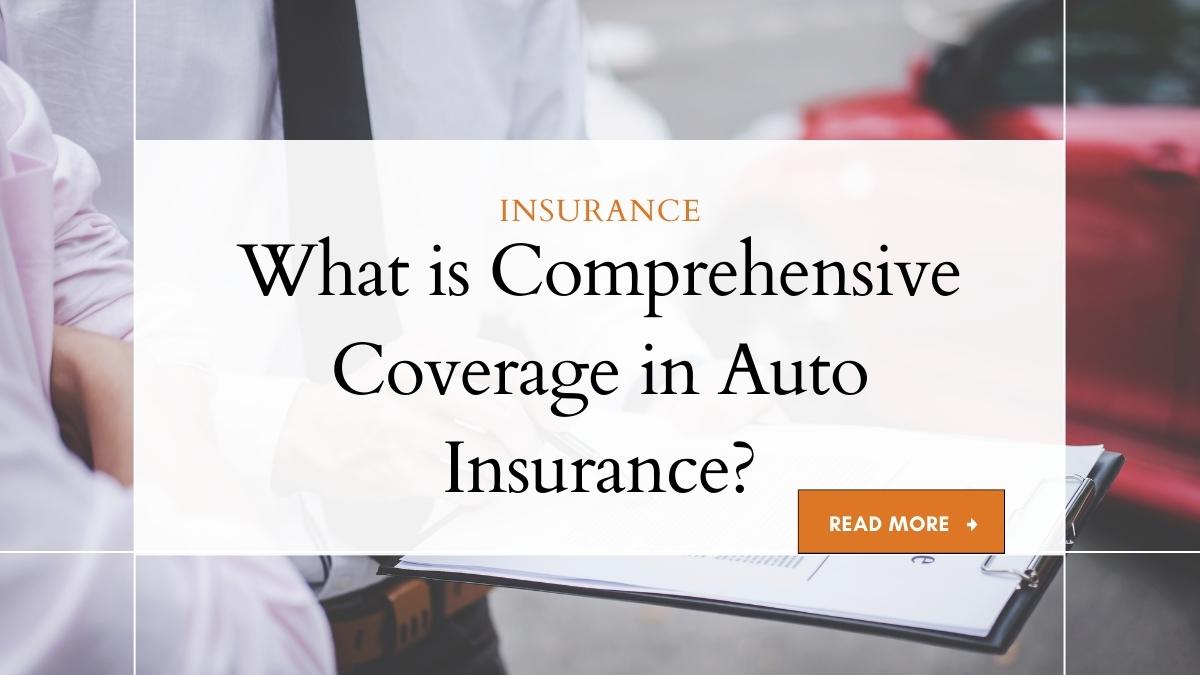
Auto insurance is an essential expense for car owners, as it provides financial protection in the event of an accident, theft, or other incidents involving their vehicle. However, understanding the different types of auto insurance coverage available and what they entail can be confusing.
One such type of coverage is comprehensive coverage, which protects against non-collision incidents that can damage or destroy a vehicle.
In this article, we will explore the ins and outs of comprehensive coverage in auto insurance, including what it is, how it works, and its benefits.
If you are a car owner, it is important to know whether you have comprehensive coverage as part of your auto insurance policy, and if not, whether it is a good idea to add it.
Comprehensive coverage can provide protection against incidents that are beyond a driver’s control, such as theft, vandalism, or damage caused by natural disasters.
However, there are limits and deductibles that car owners may need to be aware of, and the cost of comprehensive coverage may vary depending on several factors, including the age, make, and model of the car, driving record, location, and personal factors such as credit score.
By the end of this article, you will have a better understanding of what comprehensive coverage is in auto insurance and whether it is right for you.
Also, you can able to know,
What are auto insurance and its importance?
Auto insurance is a type of insurance policy that provides financial protection in case of accidents, theft, and other incidents involving a vehicle.
It is important for car owners to have auto insurance because it can help cover the costs of repairing or replacing a damaged car, as well as liability for injuries or damages caused to others.
There are different types of auto insurance coverage, including liability, collision, and comprehensive coverage.
Don’t miss: Reasons why healthcare should be free
What is comprehensive coverage?
Comprehensive coverage is an optional type of auto insurance coverage that can be added to a policy. It provides protection against a wide range of incidents that can damage or destroy a vehicle, such as theft, vandalism, natural disasters, falling objects, and animal damage.
While collision coverage is often mandatory and covers damage resulting from a collision with another vehicle or object, comprehensive coverage is more comprehensive in its protection.
The extent of coverage provided by comprehensive coverage may vary depending on the specific policy and insurance provider.
Some policies may have specific exclusions or limitations, such as coverage only for specific types of natural disasters or thefts that occur only in certain circumstances.
It is important for car owners to carefully review their policy and understand what is covered and what is not before adding comprehensive coverage to their policy.
# Comprehensive coverage is a type of auto insurance that provides protection against non-collision incidents that can damage or destroy a vehicle. This includes theft, vandalism, natural disasters such as hurricanes or floods, falling objects, and animal damage.
# Unlike collision coverage, which covers damage resulting from a collision with another vehicle or object, comprehensive coverage applies to incidents that are not caused by a collision.
Benefits of comprehensive coverage
One of the key benefits of comprehensive coverage is that it provides protection against non-collision incidents that may be out of the driver’s control.
For example, if a car is stolen or damaged due to a natural disaster such as a hurricane, flood, or wildfire, comprehensive coverage can provide the financial protection needed to cover the costs of repairs or replacement.
This can give car owners peace of mind, knowing that they are protected against a wide range of unexpected incidents that could potentially cause significant financial loss.
In addition, having comprehensive coverage can potentially save car owners money in the long run. Without comprehensive coverage, car owners would be responsible for paying out of pocket for repairs or replacement if their vehicle is stolen, vandalized, or damaged by a natural disaster.
This could be a significant expense, depending on the extent of the damage and the cost of repairs or replacement.
By adding comprehensive coverage to their auto insurance policy, car owners can mitigate this risk and avoid a potentially significant financial burden in the event of an unexpected incident.
Comprehensive coverage provides several benefits for car owners, including:
Protection against non-collision incidents
Comprehensive coverage can provide financial protection against incidents that are beyond a driver’s control, such as theft, vandalism, or damage caused by natural disasters.
Peace of mind for car owners
Knowing that their vehicle is protected against a wide range of incidents can give car owners peace of mind and reduce stress in the event of an unexpected incident.
Potential cost savings in the long run
While adding comprehensive coverage to an auto insurance policy may increase the monthly premium, it can potentially save car owners money in the long run by covering the cost of expensive repairs or replacements.
How comprehensive coverage works
When a car owner purchases comprehensive coverage as part of their auto insurance policy, they are typically covered for a wide range of non-collision incidents that may damage or destroy their vehicle.
This includes incidents such as theft, vandalism, natural disasters, falling objects, and animal damage. However, there are typically limits and deductibles that may apply, depending on the specific policy and insurance provider.
The limits of coverage for comprehensive coverage may vary depending on the policy, and car owners should carefully review their policy to understand what is covered and what is not.
For example, some policies may have limits on coverage for specific types of incidents, or they may have a cap on the total amount of coverage available.
Deductibles for comprehensive coverage may also vary, and car owners may need to pay a certain amount out of pocket before their insurance coverage kicks in.
When filing a claim for comprehensive coverage, car owners typically need to provide documentation of the incident, such as a police report or photos of the damage.
The insurance provider will then assess the claim and provide reimbursement for the costs of repairs or replacement, up to the limits of coverage and subject to any applicable deductibles.
# Comprehensive coverage typically covers the cost of repairing or replacing a vehicle that has been damaged or destroyed by a non-collision incident. However, there may be limits to what is covered and what is not covered, as well as deductibles that car owners may need to pay before the insurance kicks in.
# To file a claim for comprehensive coverage, car owners must typically provide documentation of the incident and the extent of the damage or loss.
Factors that affect comprehensive coverage rates
Several factors can influence the cost of comprehensive coverage in auto insurance. The age, make, and model of the car can play a significant role in determining the cost of coverage.
More expensive cars or cars with higher values may require higher levels of coverage, which can increase the cost of insurance.
The location where the car is parked or driven can also impact the cost of comprehensive coverage. Areas with higher rates of theft or natural disasters may require higher levels of coverage, which can drive up insurance costs.
In addition, driving record and personal factors such as credit score can also affect the cost of comprehensive coverage.
Car owners with a history of accidents or traffic violations may be considered a higher risk by insurance providers, which can result in higher rates for comprehensive coverage.
Similarly, car owners with lower credit scores may be charged higher rates for auto insurance, including comprehensive coverage.
Finally, car owners may be able to save money on comprehensive coverage by bundling it with other types of coverage, such as liability or collision coverage.
By comparing quotes from multiple insurance providers and exploring different coverage options, car owners can find the right comprehensive coverage at a price that fits their budget.
Several factors can affect the cost of comprehensive coverage, including:
Age, make, and model of the car
Newer, more expensive vehicles may require higher coverage limits and therefore have higher premiums than older or less expensive vehicles.
Driving record and location
Car owners with a history of accidents or traffic violations may pay higher premiums, as may those who live in areas with high rates of theft or natural disasters.
Personal factors such as credit score
Some insurance companies may take into account a car owner’s credit score when determining rates for comprehensive coverage.
Comprehensive Coverage FAQs
This article addresses common questions about comprehensive coverage in auto insurance, providing answers on what it is, what it covers, and how it works.
It also covers factors that affect comprehensive coverage rates and offers helpful tips for car owners looking to add this type of coverage to their policy.
What does fully comprehensive insurance cover?
Fully comprehensive insurance covers damage to your own vehicle as well as damage to other vehicles, property, and individuals involved in an accident. It also covers non-collision incidents such as theft, vandalism, and natural disasters. However, coverage may vary depending on the policy and insurance provider.
What is the comprehensive policy?
Comprehensive policy is a type of insurance coverage that provides protection against damage to your own vehicle as well as damage to other vehicles, property, and individuals involved in an accident.
It also covers non-collision incidents such as theft, vandalism, and natural disasters. The specifics of coverage may vary depending on the policy and insurance provider.
Which type of car insurance is best?
The type of car insurance that is best for you depends on your individual needs and circumstances. Liability insurance is required by law and covers damages you may cause to other people and their property.
Comprehensive and collision insurance provide additional coverage for your own vehicle. It’s important to consider your budget and the level of risk you are willing to take on when deciding on the best type of car insurance for you.
It’s also a good idea to shop around and compare quotes from different insurance providers to find the best coverage at the best price.
What is difference between comprehensive and zero DEP insurance?
Comprehensive insurance covers damages to your own vehicle as well as damages to other vehicles, property, and individuals involved in an accident. Zero depreciation (or zero DEP) insurance, on the other hand, covers the full cost of replacing parts that may need to be replaced due to damage in an accident, without factoring in depreciation.
In other words, zero DEP insurance offers more comprehensive coverage for damages to your own vehicle than traditional comprehensive insurance, but may come with a higher premium.
What is the meaning of fully comprehensive?
Fully comprehensive refers to a type of insurance coverage that provides protection against damage to your own vehicle as well as damage to other vehicles, property, and individuals involved in an accident.
It also covers non-collision incidents such as theft, vandalism, and natural disasters. The specifics of coverage may vary depending on the policy and insurance provider.
Don’t miss: What are Tax Credits for health insurance?
The bottom line
Comprehensive coverage is an important type of auto insurance that provides protection against a wide range of non-collision incidents that can damage or destroy a car.
This type of coverage can offer peace of mind to car owners, as well as potential cost savings in the long run. Understanding how comprehensive coverage works and the factors that can impact its cost is essential for car owners who want to make informed decisions about their auto insurance coverage.
Car owners who are considering adding comprehensive coverage to their auto insurance policy should review their options carefully and compare quotes from multiple insurance providers.
By working with a reputable insurance provider and selecting the right level of coverage for their needs, car owners can ensure that they have the protection they need to stay safe on the road and avoid unexpected financial expenses.
With the right auto insurance coverage, car owners can drive with confidence and peace of mind, knowing that they are protected against a wide range of risks and hazards on the road.














